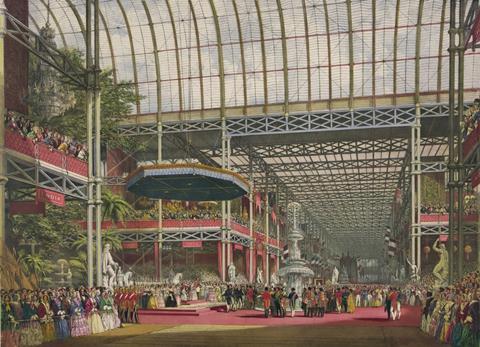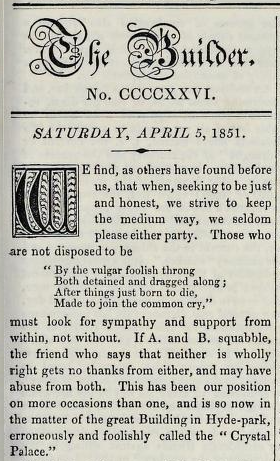‚ÄúWithin all was bustle‚Äù‚Ķ the third of our archive pieces celebrating ∫⁄∂¥…Á«¯‚Äôs 180th anniversary is an eye witness account of the chaotic scene at the Crystal Palace construction site as workers rush to get the building finished just weeks before the opening of the Great Exhibition

In the third in our series of archive pieces celebrating ∫⁄∂¥…Á«¯‚Äôs 180th anniversary, we have found an editorial from 1851 recording the frantic efforts to get the Crystal Palace ready for the Great Exhibition held that year in Hyde Park. Less than a month before the event was due to open to the six million Victorians who would visit, there was still an ‚Äúenormous‚Äù amount of work unfinished.

More than 2,000 panes of glass had broken due to high winds, causing serious leaks that had to be fixed by strapping the panes down with ties. The source of another leak was found to be a nail bag wedged into a drain pipe by a “mischievously-disposed” work man.
“Within all was bustle,” our writer says in his description of the site. “The neighbourhood was the scene of great activity, consequent on at least half-a-mile of carts and other conveyances bearing the goods to the building.”
Despite evoking a slight sense of chaos, the piece also cannot help getting swept up in the excitement of the event. The writer, who is unnamed but is presumably the editor George Godwin, includes a lengthy list of the dazzling new technologies which would be exhibited (some of which we have cut because it goes on for several pages), including a machine that could make 1,000 bricks in an hour.
Editorial in The Builder, 5 April 1851
We find, as others have found before us, that when, seeking to be just and honest, we strive to keep the medium way, we seldom please either party. Those who are not disposed to be:
“By the vulgar foolish throng
“Both detained and dragged along;
“After things just born to die,
“Made to join the common cry,”
must look for sympathy and support from within, not without. If A and B squabble, the friend who says that neither is wholly right gets no thanks from either, and may have abuse from both. This has been our position on more occasions than one, and is so now in the matter of the great building in Hyde Park, erroneously and foolishly called the “Crystal Palace”.
We have spoken our mind about it on many points, perhaps not without some good effect. We object to and reprobate the fulsome panegyrics that have been lavished upon it, and the almost daily reports of its progress throughout the press, while St Paul’s or Westminster Abbey might have grown up unnoted, praise which will cause our foreign neighbours to expect much more than they ought, and will lead hereafter, by reaction, to condemnation where it is undeserved.

While we have done this, however, we have refused to admit into our pages the statements of those who can find in it subject only for abuse; and the consequence is that, while on one hand we are regarded by some, who are personally interested in the matter, as not having a good feeling towards the building or its builders, we are scolded on the other hand for not being sufficiently “bold” to speak the truth.
During the past fortnight some correspondents of the latter bent have been indignant because we did not at once join in the cry of “a failure” when it was found that the roof was not water-tight; and to these, by the way, we will quote, in parenthesis, a remark of Boyle, who says: “Manage disputes with civility; whence some readers will be assisted to discern a difference betwixt bluntness of speech and strength of reason.”
We sincerely hope that the fears entertained as to the admission of water are exaggerated, and that the evil will not be found considerable. Much of the wet which caused alarm was admitted through broken panes of glass, of which there were, when last counted, not less than 2,000.
The action of the wind on two or three occasions produced very curious phenomena, and has led to the introduction of additional ties to prevent a recurrence of the damage to the glass which resulted. The cause of leakage in other parts has been traced to wilful stoppage of the drain-pipes* [see below].
The contractors express themselves satisfied that they will be able to make the whole water-tight; and there does not seem to be any reason to the contrary for the time during which the exhibition will be open, especially as the glass is to be covered with linen, which may be made waterproof.
Permanently water-tight, unless altered, as it seems to us, it cannot be. All who have had to do with skylights on the smallest scale, know the difficulty with which water is kept from entering through them; but beyond this, which is general, there is here this particular fact that the gutters, about which so much, too much, has been said, are simply hollowed beams of wood, and must in a short time warp and crack.
It is quite unnecessary, however, to raise any alarm on the subject, at all events, until the known causes are removed and the work finished.
When we visited the building a few days ago, the neighbourhood was the scene of great activity, consequent on at least half-a-mile of carts and other conveyances bearing the goods to the building. Within all was bustle, and not without occasion, the commissioners have announced their determination to open on the 1st of May, and the amount of work yet to be done is enormous.
Were it not that every man is directing his own business, and that on Monday there will probably be 10,000 persons at work in the building, labouring to this end, it might be pronounced impossible: giving this, however, the fullest consideration, it still seems to us very improbable. Mr Cole, Mr Dilke, and others are labouring indefatigably, and all that can be done will be. It is to be hoped that no efforts will be wanting on the part of exhibitors.
The painting is now nearly finished, and the colouring resolves itself practically into blue and white: the red does not come into sight at all, except that when looking up, the underside of the girder is brought by its means heavily to the eye.
Those who at a distance have read the discussion the original proposal produced, noted the pother it made, the principles that were evoked, and theories that were proposed, will smile incredulously at the agreeable, harmless, but mistaken reality. The outside of the building is also blue and white; the boarding of the lower storey stained and varnished as oak.
The part devoted to machinery is already full of interest: the cotton machinery will be very complete; the enormous hydraulic press used for raising the tubes of the Britannia Bridge is in its place; the permanent railway is being laid; and on all hands hammers are clanging with a will.
Down the centre of the nave will be a range of single important works, trophies, so to speak, of various departments; such as a lighthouse, the iron dome mentioned by us last week, a large fountain by Seeley, in artificial stone, a piece of statuary, and other similar striking features.
On one side, men are busily employed building a cottage of hollow bricks, and, near it, others are setting up specimens of Lord Lovelace’s moulded brickwork, in the shape of chimney-shafts and other prominent features.
Outside the building, at the west end, the engine-house is being erected, and will contain power equal to 100 horses. In the space of ground between this and the building will be deposited various specimens of “raw material”, for which room cannot be found inside, such as a monster block of coal and the like.
We have received some scores of invitations to inspect works that are about to be forwarded to the Exhibition, but, with some few exceptions, have found it necessary to decline doing so until they are in their places. Amongst those of which we have information may be mentioned a brick machine with double screw press and perpetual cutter, adapted for making Randell and Saunders’s patent bricks for sewerage purposes, which give a drain of greater strength than the common pipe or brick sewers, at a less cost; also building bricks, and all descriptions of tile and pipe ware.
The machine occupies a space 12ft by 4ft, and can be placed under the pug mill, or the clay may be thrown into it in any other way deemed desirable. The clay falls on two screws working into one another, which drive the clay out at the further end of the cylinder, giving it in its transit great compression, so that the bricks are delivered through the dies in a very firm and solid state.
On leaving the dies they pass under a perpetual cutter, which works without checking the progress of the clay, severing the bricks or tiles at any required lengths, giving joints either square, angular, circular or any segment of plain joints or tongues and grooves, in fact, giving the ends of the bricks or tiles the form required. Two men and one lad, with the machine working at little over one-horse power, produce, it is said, 1,000 bricks per hour.
*Along a row of columns on the south side there was observed to be a constant leakage when rain fell, from some cause which could not be detected. At last they were induced to examine the line of drainpipes which runs from column to column, and there they discovered a nail-bag securely wedged in by some mischievously-disposed workman, and which, by stopping the current of water, of course caused the columns to overflow.
>> Also read: From the archives: The construction of the Palace of Westminster, 1847
>> Also read: From the archives: Benjamin Disraeli’s proposal to hang architects, 1847


























No comments yet